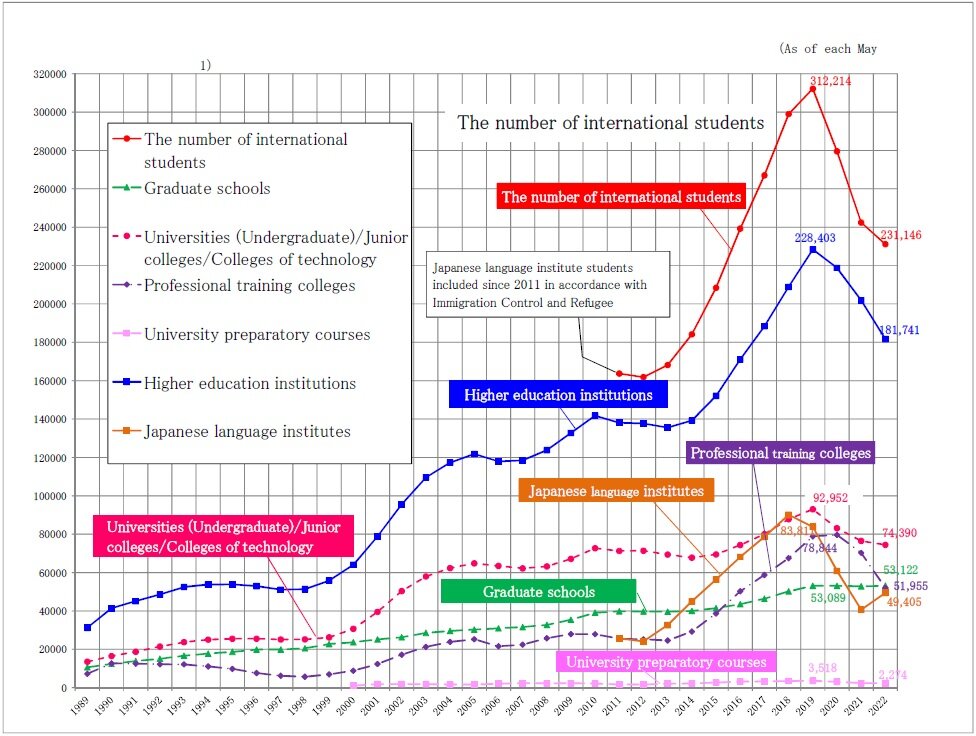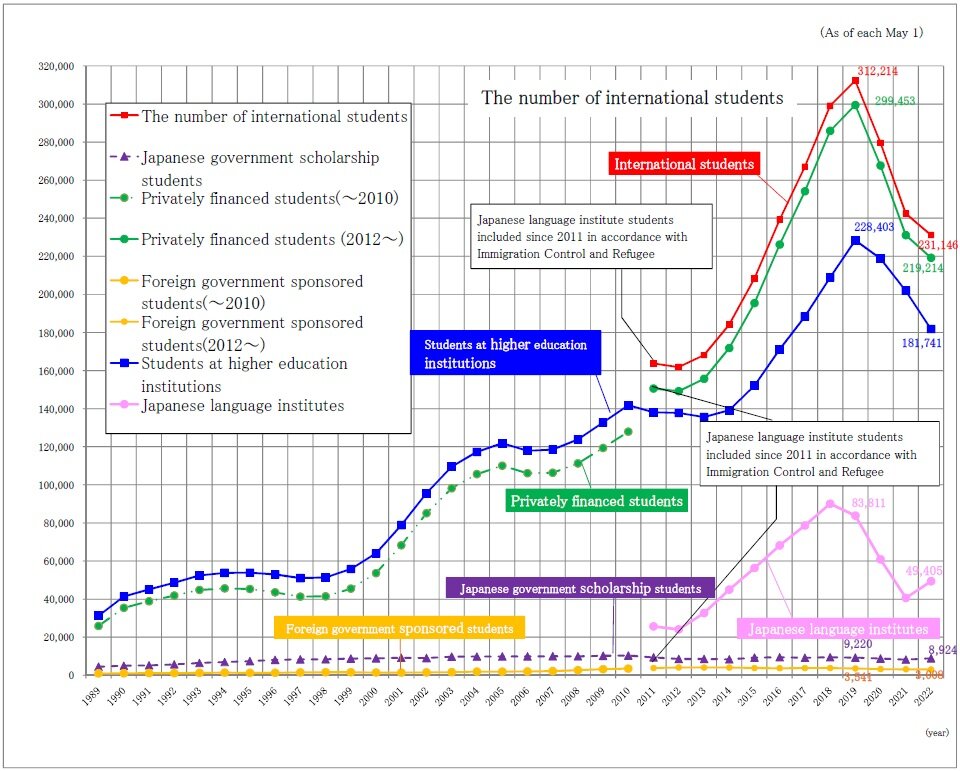- HOME
- Statistics
- Annual Survey of International Students in Japan
- Result of International Student Survey in Japan, 2022
Result of International Student Survey in Japan, 2022
March, 2023
Japan Student Services Organization(JASSO)
1. Overview of international students acceptance
231,146 international students in Japan as of May 1, 2022
4.7% decrease from last year.
| Number of students | Increase from the previous year | |||
|---|---|---|---|---|
| 2022 | 2021 | Increase | Increase rate | |
| Graduate schools | 53,122 | 52,759 | 363 | 0.7 |
| Universities (undergraduate) | 72,047 | 73,715 | ▲1,668 | ▲2.3 |
| Junior colleges | 1,863 | 2,331 | ▲468 | ▲20.1 |
| Colleges of technology | 480 | 453 | 27 | 6.0 |
| Professional training colleges | 51,955 | 70,268 | ▲18,313 | ▲26.1 |
| University preparatory courses | 2,274 | 2,351 | ▲77 | ▲3.3 |
| Japanese language institutes | 49,405 | 40,567 | 8,838 | 21.8 |
| Number of students | Increase from the previous year | |||
|---|---|---|---|---|
| 2022 | 2021 | Increase | Increase rate | |
| China | 103,882 | 114,255 | ▲10,373 | ▲9.1 |
| Vietnam | 37,405 | 49,469 | ▲12,064 | ▲24.4 |
| Nepal | 24,257 | 18,825 | 5,432 | 28.9 |
| Republic of Korea | 13,701 | 14,247 | ▲546 | ▲3.8 |
| Indonesia | 5,763 | 5,792 | ▲29 | ▲0.5 |
International Student Survey in Japan, 2022 investigates the enrollment situation of international students in Japan (in the fiscal year 2022, as of May 1) at graduate schools, universities (four-year institutions), junior colleges (two-year institutions), colleges of technology, professional training colleges, Japanese language institutes and university preparatory courses (hereafter collectively referred to as "Japanese School"). The objectives of this survey are to acquire a deeper understanding of international students' facts and figures in Japan.
Note 1: This survey had been conducted annually by Ministry of Education, Culture, Sports, Science and Technology (MEXT) until 2003, is now administered by Japan Student Services Organization (JASSO), which was founded in April 2004 as an Independent Administrative Institution.
Note 2: The term "international student" as used in this survey is defined pursuant to provisions of Appended Table 1 of the "Immigration Control and Refugee Recognition Act," as a student from a foreign country who is granted the status of residence as " Student" and who is receiving education at a Japanese School.
Note 3: A new simplified student visa framework was launched on July 15, 2009 under the "Immigration Control and Refugee Recognition Act"; international students enrolled in Japanese language institutes were incorporated in 2011 from "Pre-College Student" to "Student".
Note 4: "Japanese government scholarship (for overseas) students" refer to students who receive financial aid from MEXT in the form of the Japanese government (MEXT) scholarship program established in 1954 or the Japan-Korea Joint Exchange Program in Science and Engineering Students scholarship and the Japan-Korea Government Scholarship programsponsored by Japanese government.
Note 5: "Foreign government-sponsored students" receive financial assistance from their own countries/region's government or related institutions.
Note 6: "Short-term international students" refer to students who enroll in Japanese Schoolsto take less than one year of courses and obtain credit but do not necessarily receive an academic degree. These courses offer a variety of programs related to Japanese language or culture.
Note 7: The university preparatory course designated by MEXT is for international students who are pursuing higher education but who have not completed a total of twelve years' worth of precollege education yet.
Note 8: Among the Japanese government scholarship students, those who enrolled in the university preparatory courses, are counted as Japanese language students since 2020, instead of counting them as students in their planned type of school after the completion of their preparatory courses.
Note 9: The number of this survey includes the international students who had not entered in Japan by May 1, 2022 due to the immigration restriction caused by the Covid-19 pandemic, as long as they had finished their enrollment procedures and obtained the Certificate of Eligibility (COE).
Note 10: The sum total of each item may not exactly match the number shown in the table's total values column/row because the numbers have been rounded off.
This survey aggregated the answers from Japanese Schools as of December, 2022
2. Trends in Number of International Students by Source of Funds (As of each May 1)
3. Trends in Number of International Students by Institutional Type (As of each May 1)


